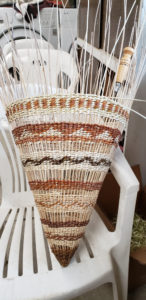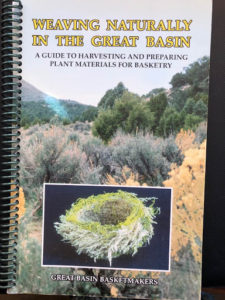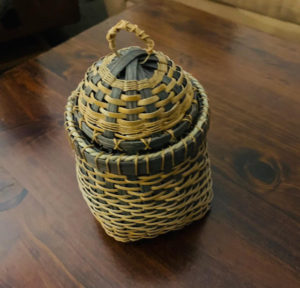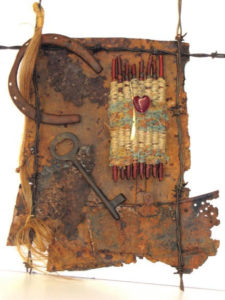Great Basin Basketmakers
A Conversation With Betty Hulse
![]()
Zoom, Facetime and the telephone. In the Before Times, we might have met up for lunch, but the phone and internet are now our Covid Time interview tools.

Sue Ann Montelone
Recently, Betty Hulse and I had tea by telephone for a broad-ranging conversation on the Great Basin Basketmakers guild. While not a member of CNCH, GBB has been quite active in Nevada basketry for several decades. Betty told me that “the guild took root back in 1987 when Mary Lee Fulkerson was on the hunt for honeysuckle vines. Four avid weavers responded to Mary Lee’s quest and the guild began.”
From that small but dedicated start, the guild has grown to more than 60 members.
Once a vast inland sea rich in prehistoric culture, members hail primarily from the Great Basin region of Nevada, California, Oregon, and Utah.
“In the early years,” Betty related, “basket materials were collected from members’ gardens – daylily and iris leaves, and of course, honeysuckle.”

Soon members were responsibly sourcing wild materials such as native willow, tule, and cattail from the wetlands surrounding Reno. As development in the Basin increases, wetlands decrease. Pesticide use has brought with it a health hazard awareness among collectors and weavers.
Wild willow spreads by its roots, so GBB works with Washoe County Parks with annual pruning in Idyllwild Park. Members have also created willow play tunnels for children at Idyllwild. Cultivated strains of willow do not spread by the roots, so GBB is creating a patch in the park, sourcing starts from an ethnobotanist in Oregon, as well as horticulturists in Germany and England.

Susan Lester
“By 1999,” Betty shared, “we developed a nine-month traveling exhibition throughout the state, culminating in Las Vegas. Workshops were offered, too.”
In 2003, Betty and Mary Lee hatched another ambitious project, Weaving Naturally in the Great Basin, a 100-page guidebook packed with harvesting and basketry material preparation. Following an introduction to the ancient Great Basin landscape and culture, an alphabetic collection of the primary plants guides the collector to the best times of year for collecting, as well as preparation for the materials. The book culminates with several tutorials on projects utilizing different weaving techniques. (Contact Janice Johnson at janiceattheranch@gmail.com to purchase your own copy)
In addition to exhibits at Brewery Arts in Carson City, they have also exhibited at local libraries, the Nevada Historical Society, and the historic Fourth Ward School in lively Virginia City. Interwoven 2010 saw a juried show at the Nevada State Museum in Carson City. “Members wove four large woven sculpture/baskets – a dust devil, a four-foot bird nest, a bridge to symbolize past and future, and a four-foot coiled basket. In 2017, GBB partnered with the Reno Tahoe International Airport to showcase a 30-year collection of over 200 baskets.”
Education is a big part of the guild’s experience and for over 10 years, they have hosted 3-day weaving retreats at Lake Tahoe. Sadly, 2020 and 2021 were cancelled, but plans are in the works to return next year. Additional workshops are usually held throughout the year. In the meantime, Zoom keeps the far-flung members connected.
Betty said, “We bring in instructors from across the United States and they share new ideas, materials and weaving processes. The guild also maintains a comprehensive library at the Masonic Hall, where we meet.”

Cherlyn Bennett
Membership is $25 per year and includes a monthly newsletter, access to the library, and member rates on workshops. More information is available on their website at www.greatbasinbasketmakers.org